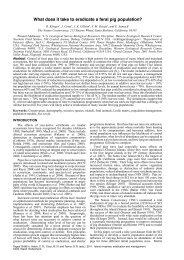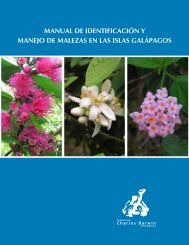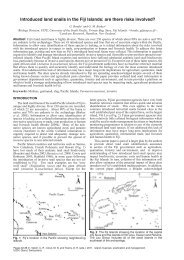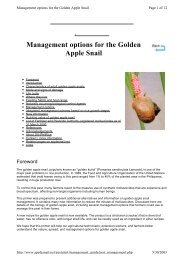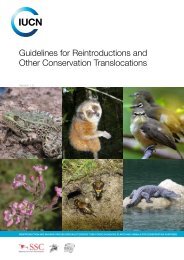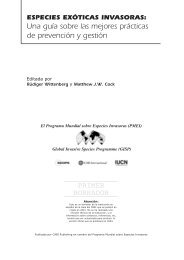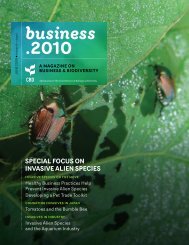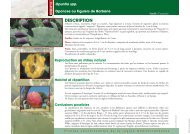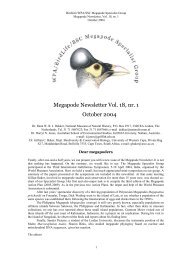Aliens Newsletter - ISSG
Aliens Newsletter - ISSG
Aliens Newsletter - ISSG
Create successful ePaper yourself
Turn your PDF publications into a flip-book with our unique Google optimized e-Paper software.
Seychelles Islands R. rattus and R. norvegicus did<br />
not occur on the same islands (Hill et al. 2003).<br />
According to the Global Invasive Species Database<br />
(2009) the black rat, Rattus rattus, is included in the<br />
100 of the World’s Worst Invasive Alien Species list<br />
(www.issg.org/database). This species has colonized<br />
a large number of islands worldwide, with a significant<br />
negative impact on numerous species (eventually<br />
leading to bird extinctions). In fact, among the<br />
three invasive rat species (R. rattus, R. norvegicus<br />
and R. exulans Peale, 1848), R. rattus may be considered<br />
the most harmful (Jones et al. 2008). R. rattus<br />
was introduced to central Chile during the<br />
1600’s, but the introduction date on the islands and<br />
archipelagos of southern Chile is unknown (Jaksic<br />
1998).<br />
The stomach content of the R. rattus individuals<br />
showed that they are probably consuming chicks but<br />
it is necessary to perform stable isotopes analyses<br />
( 13 C and 15 N) to confirm this and direct observations<br />
to discriminate between direct predation and scavenging<br />
(Stapp 2002, Caut et al. 2008). However,<br />
there are many reports that have confirmed rat’s predation<br />
and its consequences on insular birds (egg,<br />
chicks and adults) (e.g. Atkinson 1985, Jouventin<br />
et al. 2003). R. rattus is a general predator that is<br />
able to change its diet depending on the resources<br />
availability (Caut et al. 2008); therefore its presence<br />
on Guafo Island implies a potential threat to this<br />
seabird and also to other species.<br />
A recent review indicates that rat eradication attempts<br />
have been successful, and in the case of black<br />
rat eradication have succeeded on 159 islands and<br />
failed only on 15 islands (Howald et al. 2007), Hermite<br />
Island being the largest one with 1022 ha.<br />
Guafo Island is one order of magnitude larger than<br />
Hermite Island and although an increase in scale<br />
could be correlated with an increase in habitat complexity,<br />
scale per se has not deterred managers from<br />
planning eradication of black rats with an acceptable<br />
risk of failure (e.g. Macquarie Island and Tristan<br />
da Cunha Island) (Parkes 2008). However basic<br />
knowledge of R. rattus ecology (e.g. annual intrinsic<br />
rate of increase, migration, density fluctuations,<br />
breeding season, annual variation in body condition,<br />
home range and daily movements) and a full<br />
feasibility study (e.g. Parkes 2008) is required to estimate<br />
costs, risks and constraints inherent in any<br />
attempt to eradicate rats from Guafo Island.<br />
The P. griseus colony from Guafo Island is only the<br />
third reported in South American waters for this<br />
species, and despite of the fact that it is the largest<br />
in the world (Reyes-Arriagada et al. 2007) it has no<br />
formal protection under Chilean laws. Further research<br />
is therefore clearly needed for this colony, in<br />
order to improve the basic knowledge and also to<br />
implement management and conservation measures,<br />
including rat eradication. This is likely to be necessary<br />
because although the declines of up to 90%<br />
of sooty shearwater populations in the California<br />
Current were attributed to factors such as fisheries<br />
interaction (Veit et al. 1996) and global climate<br />
change (Veit et al. 1997), the presence of rats and<br />
other introduced species on this breeding colony<br />
could be a factor contributing to the population decline.<br />
Finally, to fully understand the population status<br />
of P. griseus along the eastern Pacific coast<br />
(Chile) more research is required and this must be<br />
integrated with the knowledge generated in the western<br />
Pacific. This will allow the implementation of<br />
management plans and conservation measures at a<br />
global scale.<br />
References<br />
Atkinson IAE (1985) The spread of commensal<br />
species of Rattus to oceanic islands and their effect<br />
on island avifaunas. Conservation of Island<br />
Birds 3:35-81<br />
Atkinson IAE (1986) Rodents on New Zealand’s<br />
northern offshore islands: distribution, effects<br />
and precautions against further spread. In: The<br />
offshore islands of northern New Zealand (ed.<br />
by AE Wright & RE Beever), pp.13-40. N.Z. Department<br />
of Lands and Survey, Information Series<br />
Nº 16. Wellington, New Zealand<br />
Briggs KT, Chu EW (1986) Sooty shearwaters off<br />
California: distribution, abundance and habitat<br />
use. Condor 88: 355-364<br />
Brothers NP (1984) Breeding, distribution and status<br />
of burrow-nesting petrels at Macquarie Island.<br />
Australian Wildlife Research 77:113-131<br />
Caut S, Angulo E, Courchamp F (2008). Dietary<br />
shift of an invasive predator: rats, seabird and<br />
sea turtles. Journal of Applied Ecology 45:428-<br />
437<br />
Clucas RJ, Fletcher DJ, Moller H (2008). Estimates<br />
of adult survival rate for three colonies of sooty<br />
shearwater (Puffinus griseus) in New Zealand.<br />
Emu 108:237-250<br />
Cooper J, Underhill LG, Avery G (1991) Primary<br />
moult and transequatorial migration of the<br />
sooty shearwater. Condor 93:724-730<br />
Dulloo ME, Kell SR, Jones CG (2002) Impact and<br />
control of invasive alien species on small islands.<br />
International Forest Review 4:277-285<br />
<strong>Aliens</strong> 37



